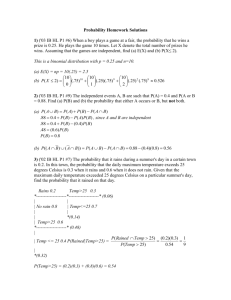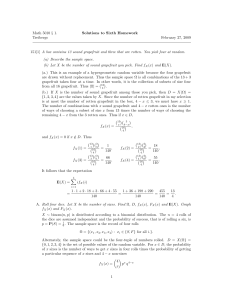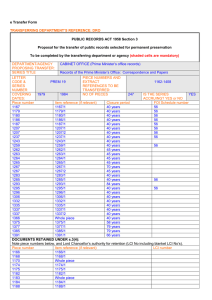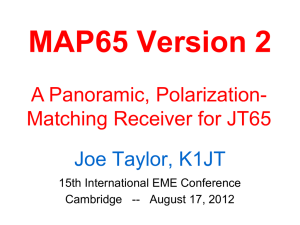Probability Homework
advertisement
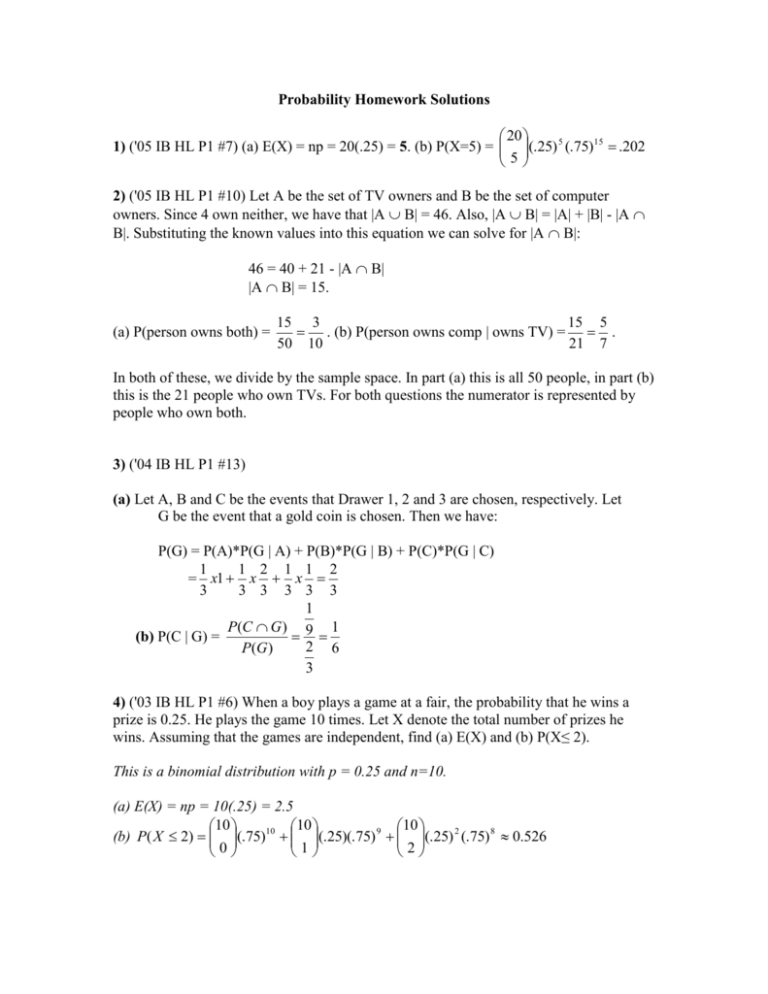
Probability Homework Solutions
20
1) ('05 IB HL P1 #7) (a) E(X) = np = 20(.25) = 5. (b) P(X=5) = (.25) 5 (.75)15 .202
5
2) ('05 IB HL P1 #10) Let A be the set of TV owners and B be the set of computer
owners. Since 4 own neither, we have that |A B| = 46. Also, |A B| = |A| + |B| - |A
B|. Substituting the known values into this equation we can solve for |A B|:
46 = 40 + 21 - |A B|
|A B| = 15.
(a) P(person owns both) =
15 3
15 5
. (b) P(person owns comp | owns TV) = .
50 10
21 7
In both of these, we divide by the sample space. In part (a) this is all 50 people, in part (b)
this is the 21 people who own TVs. For both questions the numerator is represented by
people who own both.
3) ('04 IB HL P1 #13)
(a) Let A, B and C be the events that Drawer 1, 2 and 3 are chosen, respectively. Let
G be the event that a gold coin is chosen. Then we have:
P(G) = P(A)*P(G | A) + P(B)*P(G | B) + P(C)*P(G | C)
1
1 2 1 1 2
= x1 x x
3
3 3 3 3 3
1
P(C G ) 9 1
(b) P(C | G) =
2 6
P(G )
3
4) ('03 IB HL P1 #6) When a boy plays a game at a fair, the probability that he wins a
prize is 0.25. He plays the game 10 times. Let X denote the total number of prizes he
wins. Assuming that the games are independent, find (a) E(X) and (b) P(X≤ 2).
This is a binomial distribution with p = 0.25 and n=10.
(a) E(X) = np = 10(.25) = 2.5
10
10
10
(b) P( X 2) (.75)10 (.25)(.75) 9 (.25) 2 (.75) 8 0.526
0
1
2
5) ('02 IB HL P1 #7) The probability that it rains during a summer's day in a certain town
is 0.2. In this town, the probability that the daily maximum temperature exceeds 25
degrees Celsius is 0.3 when it rains and 0.6 when it does not rain. Given that the
maximum daily temperature exceeded 25 degrees Celsius on a particular summer's day,
find the probability that it rained on that day.
Rains 0.2
Temp>25 0.3
*--------------------*--------------------* (0.06)
|
|
| No rain 0.8
| Temp<=25 0.7
|
|
|
*(0.14)
| Temp>25 0.6
*--------------------* (0.48)
|
P( Rained Temp 25) (0.2)(0.3) 1
| Temp <= 25 0.4 P(Rained|Temp>25) =
P(Temp 25)
0.54
9
|
*(0.32)
P(Temp>25) = (0.2)(0.3) + (0.8)(0.6) = 0.54
6) ('02 IB HL P1 #9) When John throws a stone at a target, the probability that he hits the
target is 0.4 He throws a stone 6 times. (a) Find the probability that he hits the target
exactly 4 times. (b) Find the probability that he hits the target for the first time on his
third throw.
This is another binomial distribution with p=0.4 and n=6.
6
(a) (0.4) 4 (0.6) 2 .13824
4
(b) (0.6)(0.6)(0.4) = .144, since each of the first three throws is forced to be a particular
outcome.
7) ('01 IB HL P1 #11)
P(Y X ) P(Y X ) 2
4
P(Y | X )
, thus P (Y X )
15
P( X )
23
5
P(Y X ' ) P(Y X ' ) 1
1
P(Y | X ' )
, thus P (Y X ' )
12
P( X ' )
13
4
(a) Thus, we have P(Y ' ) 1 P(Y ) 1 ( P(Y X ) P(Y X ' )) 1
(b) P( X 'Y ' ) 1 P( X Y ) 1
4 11
15 15
4 1 13
15 12 20
8) ('00 IB HL P1 #7) Let P(n) denote the probability of obtaining a sum of n after two
rolls, and P(a,b) denote the probability of rolling a followed by rolling b. Then we have:
P(6) = P(2,4) + P(3,3) + P(4,2)
= (2/5)(3/10) + (1/10)(1/10) + (3/10)(2/5)
=1/4
9) ('00 IB HL P1 #12) Since the sum of all probabilities must be one, we have
1
1
2 x
2
) 1 , thus k
k
(
)
1
k
( )x 1 , k(
,
so
3
1 2 3
3
x 0
x 0 3
10) ('04 IB HL P2 #2(i))
2
(a) , since 4 out of 6 opening rolls wins.
3
1 2 2
(b) P(Jill wins on the 1st throw) = P(Jack gets 5 or 6)*P(Jill gets 1,-4) = x
3 3 9
(c) Let X be the probability that the person who rolls first wins. Then 1-X is the
probability that the person who rolls second wins. Notice that X is the sum of the
probability that Jack wins on the first roll plus the probability that he wins on a later roll.
Since the first part of this was determined in (a), we must only determine the probability
that Jack wins on a later roll. In order for this to occur, he must roll a 5 or 6, followed by
Jill taking a turn. When Jill takes her turn, her probability of winning is now X (since in
essence, she is the first player in the game), and her probability of losing is 1-X. Thus the
probability of Jack winning is this product. This leads us to the equation:
2 1
X (1 X )
3 3
X
X 1
3
3
X
4
A more straight-forward way of solving the problem is as follows:
P(Jack wins on roll k) =
P(Jack and Jill roll 5 or 6 for k-1 turns)*P(Jack rolls a 1,2,3 or 4)=
k 1
1 1
2 1
2
( x ) k 1 x
x
3 3
3 9
3
P(Jack wins) =
1
(9)
k 1
k 1
2 2 1
2
1
2 9 3
( ) ( )k x
x
1 3 8 4
3 3 k 0 9
3
1
9
11) ('03 IB HL P2 #4)
(a) (i) Write down the integral whose value is E(X).
2
1
12 (8x x
3
) xdx
0
(ii) Hence evaluate E(X).
2
2
1
1
2 3 x 5 2 56
3
2
4
(
8
x
x
)
xdx
(
8
x
x
)
dx
x
|0
0 12
12 0
9
60
45
(b) (i) Show that the median, m, of X satisfies the equation m4 - 16m2 + 24 = 0.
n
1
12 (8x x
3
0
)dx
1
2
1
x4
1
(4 x 2 ) |0m
12
4
2
4
1 2 m
1
m
3
48 2
4
m 16m 2 24 0 , by multiplying through by 48 and rearranging terms.
(ii) Hence evaluate m.
16 256 4(24)
160
8
8 2 10
2
2
Of these two roots, only one, 8 2 10 , could be the median, because we know
That the median must be in between 0 and 2 inclusive. This value is approximately
1.675.
Using the quadratic, we get m 2
(c) Evaluate the mode of X.
We must find the value of x for which the given function is maximum.
f ' ( x)
1
(8 3 x 2 ) . Setting the derivative of the function, we find a turning point at
12
2 6
1.63 . We can verify that this is a relative maximum because the derivative of
3
f'(x) is a decreasing function over the interval [1,2].
x=
12) ('02 IB HL P2 #4)
(a) (i) Calculate the probability that Alan obtains a score of 9.
4 1
, since the rolls (3,6), (4,5), (5,4) and (6,3) sum to 9 out of the
36 9
36 possible rolls.
(ii) Calculate the probability that Alan and Belle both obtain a score of 9.
P( A 9 B 9)
1 1 1
, since their rolls are independent.
9 9 81
(b) (i) This is tedious. In general, if the probability of obtaining some score is k, the
probability both of them obtain it is k2. So, we must sum over all 11 possible scores.
1 2
2
3
4
) ( )2 ( )2 ( )2
36
36
36
36
5
6
5
4
( )2 ( )2 ( )2 ( )2
36
36
36
36
3 2
2 2
1 2 146
73
( ) ( ) ( )
36
36
36
1296 648
P( A B) (
1 P( A B)
(ii) P( A B) P( B A) , so P( A B)
2
1
73
648 575
2
1296
x
, since there are x choices out of
6
six sides that will satisfy the requirement. Since each of the four dice rolls are
independent of one another, we can calculate the probability that none of them exceeds x
x x x x
x
to be the product ( ) ( ) ( ) ( ) = ( ) 4 , as desired
6 6 6 6
6
(ii)
(c) (i) The probability of obtain a score of x or less is
x
P(X = x)
1
1/1296
2
15/1296
3
65/1296
4
175/1296
5
369/1296
(iii) E ( X )
1
2 15 3 65 4 175 5 369 6 671 6797
5.24
1296 1296 1296
1296
1296
1296
1296
6
671/1296
